This article is part of our body language guide. Click here for more.
Do you know why Michael Jordan1https://www.sportscasting.com/michael-jordans-father-was-the-reason-his-tongue-was-always-sticking-out/ often sticks his tongue out during his basketball games?
He developed this habit by copying his late father as a kid. Whenever he had to focus or concentrate on something in the game, his tongue would come out.
The world of mouth and lip body language is ripe with unique quirks and hidden tells. What do pursed lips mean? What about sucked-in lips, licking lips, gasps of air, or mouth stretching?
In this ultimate mouth guide, you will learn:
- when to smile during a business meeting (and when not to)
- how to know when someone wants to talk with you before you even speak
- the hidden meanings behind pursed lips
- how you can tell a smoker will buy your proposal, just by observing
- the best color lipstick to wear and when

Can You Read Body Language?
How good are your body language skills? Take our free body language quiz to find out!

6 Smiling Cues You Should Know
Did you know that women smile when they know they are being observed or are feeling anxious? Or how about that smiling happens more often when it’s sunny and pleasant than when it’s rainy or overcast2https://www.amazon.com/Nonverbal-Communication-Human-Interaction-Knapp/dp/1133311598?
Smiling is one of the most powerful cues we have. And there are so many types of smiles—I’ve found there are 6. Here are the different smiles and what they mean:
Duchenne Smile
What is the only facial expression recognized at around 90% accuracy by people tested in Japan, Brazil, Chile, Argentina, and the US? Yep, this was happiness1.
The smile is universal.
Smiles are quite common in normal conversation, and we can smile dozens of times in a normal conversation. Smiling is even one of the most natural body language cues: studies3https://www.ncbi.nlm.nih.gov/pmc/articles/PMC5902524/ show that babies born blind smile automatically at the sound of their mother’s or father’s voice from the fourth week of life onward.
And the Duchenne smile is the smile that indicates genuineness.
An indicator of a genuine smile is the zygomaticus major, or the muscle that activates in a smile. In one study, the frequency, duration, and intensity of action of the zygomaticus major muscle correlated with how much happiness people said they felt while watching different kinds of films2https://www.amazon.com/Nonverbal-Communication-Human-Interaction-Knapp/dp/1133311598.
In other words… the happier someone is, the more their zygomatic muscle activates.
But it’s not all about the zygomatic. If there’s one key element missing from the smile, it may still be “fake.” In another study, “masking” smiles from participants who were told to smile and lie about their experience after watching a stressful film had zygomatic major muscle activity but not orbicularis oculi movement.
This means a genuine smile is often characterized by crow’s feet—otherwise, the smile may be a “fake happiness” smile done out of politeness.
Watch our video below to learn how to read people and decode 7 body language cues:
Pro Tip: When to Smile and When Not To
Science shows there is a time to smile and a time to avoid it. In one study, 257 respondents viewed 15 photos of women showing happy, sad, and neutral faces and rated them for attractiveness4https://www.amazon.com/Definitive-Book-Body-Language-attitudes/dp/1409168506.
Unsmiling women were decoded as unhappy, while unsmiling men were viewed as dominant.
So, women should mirror others’ smiling—especially in a business context—and generally smile to appear happy, while men should generally smile more—in all contexts—to tone down the dominance and be more persuasive with women.
We also smile when our “inner child” wakes up, like in this hilarious incident with former US president George Bush (timestamp 0:24):
The model smile
What It Means: The model smile is the type of smile that actors, models, and celebrities will do on the red carpet. It’s a big smile but one that doesn’t necessarily indicate genuine happiness.

Can We “Catch” Emotions?
Here’s a question—does happiness really spread? Dr. Wild and her research team5https://www.researchgate.net/publication/11931976_Are_Emotions_Contagious_Evoked_Emotions_while_Viewing_Emotionally_Expressive_Faces_Quality_Quantity_Time_Course_and_Gender_Differences showed people pictures of happy or sad faces. Then they gave them a series of mood tests. They found they could “infect” participants with the emotions in each image. When people viewed a happy face, they felt happier. After viewing a sad face, people felt negative. They only flashed each image for 500 microseconds, and participants still caught the emotion. So if you need a reason to smile, remember that happiness spreads!
The half smile
What It Means: The half smile is also called “duping delight” and is used to describe when a person tries to get away with something, outwits someone, or gets away with a lie. It’s a pretentious smile when other emotions are more appropriate, such as humility or seriousness. Check out this baby who flashes the half smile (timestamp 0:08):

Fake smile
What It Means: The fake smile is generally used to be socially accepted and keeps our channels open, signaling we are open to communication2https://www.amazon.com/Nonverbal-Communication-Human-Interaction-Knapp/dp/1133311598. You might also see a polite but fake smile from acquaintances you meet at an ugly sweater Christmas party.
Heck, even babies only several weeks old know how to fake it. They will already reserve the zygomatic smile (real smile) for their mothers and utilize the risorius smile (the fake one) for others6https://www.amazon.com/What-Every-Body-Saying-Speed-Reading/dp/0061438294.
So how do you detect a fake smile?
You can detect a fake smile if it is only as short as ⅔ of a second or longer than 4 seconds.
Do Women Really Like Being Flirted With?
One study shows that when female job interviewees were subjected to a sexually provocative statement, they responded with a fake smile just to “get through it” and out of politeness. But the men who were likely to make provocative statements perceived these smiles as flirtatious instead.
These men lacked the ability to decode the fake smile. So what if the women didn’t smile? They thought of them as vulnerable and confused, not turned off2https://www.amazon.com/Nonverbal-Communication-Human-Interaction-Knapp/dp/1133311598.
You may also see fake smiling happen when a person is nervous. For example, to appease the officers, airport passengers may nervously smile while going through customs6https://www.amazon.com/What-Every-Body-Saying-Speed-Reading/dp/0061438294.
Pro Tip: Watch for Oversmiling
Smiling is submissive, and powerful people smile less. However, oversmiling can also be negative and may mean someone is trying to please you.
Slight smile
What It Means: Psychologist Ronald Riggio7https://www.psychologytoday.com/intl/blog/cutting-edge-leadership/201604/5-types-smiles-and-what-they-mean says “a slight smile that accompanies direct eye contact, with a slow glance away, but still holding the smile” is a strong sign of seduction. Look for this cue if you make eye contact with a potential partner at the bar or club.
Closed-mouth smile
What It Means: A closed-mouth smile is often considered in the primate world as a submissive display8https://www.researchgate.net/publication/243768681_Human_facial_expressions_as_adaptations_Evolutionary_questions_in_facial_expression_research. People who are particularly shy about their teeth will often do the closed-mouth smile.

You might also see a tight smile is formed when the central part of your lips is strongly pursed, with the mouth corners pulled back as in an ordinary smile6https://www.amazon.com/What-Every-Body-Saying-Speed-Reading/dp/0061438294. This may indicate a person is holding back tension and anger but is trying to appear happy.
Warning: Potentially Disturbing Content Ahead
Some smiles can even be devious, like when someone almost gets away with a bad crime. Here’s an example of Neil Entwistle at a trial. Neil watches a video of the fatal shooting of his wife and infant daughter9https://www.amazon.com/You-Say-More-Than-Think/dp/0307453987. However… he doesn’t seem to be crying at all. His mouth is upturned, and you can even see the crow’s feet on the corners of his eyes. He actually looks like he’s getting enjoyment from this! (timestamp 0:02)
Other Smiling Tips to Know
Who knew there was so much science of smiling? Smiling is one of the most powerful gestures of all time. Here are some more interesting facts you should know about smiling:
- Women also generally smile more than men, especially when around people they are not very familiar with2https://www.amazon.com/Nonverbal-Communication-Human-Interaction-Knapp/dp/1133311598.
- A Duchenne smile can even be faked. Those who can reproduce a Duchenne smile on command are more persuasive.
- People tend to smile more with others than alone2https://www.amazon.com/Nonverbal-Communication-Human-Interaction-Knapp/dp/1133311598.
- Studies show athletes’ smiles differ noticeably, depending on whether they finish first, second, or third place. This distinction is the same in congenitally blind athletes who’ve never seen a smile before4https://www.amazon.com/Definitive-Book-Body-Language-attitudes/dp/1409168506.
- Gold medalists filmed during the Olympic games showed winners smiled most10http://www.communicationcache.com/uploads/1/0/8/8/10887248/are_smiles_a_sign_of_happiness_-_gold_metal_winners_at_the_olymic_games.pdf when interacting with the public, compared to when standing behind a podium away from the public or standing on the podium while listening to the national anthem.
- Even the imagined presence of others may cause us to smile.
- Subordinate people smile more when dominant and high-status people are around4https://www.amazon.com/Definitive-Book-Body-Language-attitudes/dp/1409168506.
- A woman’s smile is a “badge of appeasement” and can be used to placate a more powerful male4https://www.amazon.com/Definitive-Book-Body-Language-attitudes/dp/1409168506.
- In social encounters, women smile 87% of the time, versus 67% for men4https://www.amazon.com/Definitive-Book-Body-Language-attitudes/dp/1409168506..
- Women are 26% more likely than men to return smiles from the opposite sex4https://www.amazon.com/Definitive-Book-Body-Language-attitudes/dp/1409168506.
- Research shows that men tend to mistake friendliness and a smile for sexual interest, because men see the world in more sexual terms than women, as men have 10–20 times more testosterone than women4https://www.amazon.com/Definitive-Book-Body-Language-attitudes/dp/1409168506.
- There’s another smile called an “indeterminate smile.” Think of the Mona Lisa. It is a smile that seems like it could move to any feeling: laughing, crying, angry or fearful11https://www.amazon.com/Winning-Body-Language-Conversation-Attention/dp/0071700579.

10 Lip Gestures You Should Know
Do you know the difference between lower lip biting and upper lip biting? How about disappearing lips or pursed lips?
Our lips change in size according to our emotional state. When comfortable and relaxed, they are fuller. However, when you’re under stress, your blood flows from the lips to other parts of the body where blood circulation is needed the most, making them smaller12https://www.amazon.com/Dictionary-Body-Language-Field-Behavior/dp/0062846876.
Read on to find out more about the intricate language of the lips.
Pursed lips (the small-mouth gesture)
What It Means: Pursing lips or sucking your lips in could indicate stress, or it could also mean that you’re holding back from something and trying to control your facial expressions. Rhesus monkeys do this and also raise their brows, fix their gaze, and close their jaws together when disposed to attack2https://www.amazon.com/Nonverbal-Communication-Human-Interaction-Knapp/dp/1133311598.
It is also used today if someone is intimidated by inferior people, often accompanied by rapid blinking. Some people will even compress their lips in a restrained, polite smile. For example, if you are passing by a stranger and smile politely (hint: they don’t really care).
Henry VIII was also famous for this pursed-lip expression. You can see that in many of his portraits. The small-mouth gesture used to signify superiority among English aristocrats in the 16th Century.

Watch as Canadian prime minister Justin Trudeau takes a long pause before answering and purses his lips. This implies that he is holding back information, and you may see this with many politicians as they consider their answers before speaking (timestamp 0:25):
Pursed lips can often be seen during closing arguments at a trial—when one attorney speaks, the opposing side may purse their lips in disagreement6https://www.amazon.com/What-Every-Body-Saying-Speed-Reading/dp/0061438294. Judges also do it if they disagree with attorneys during sidebar conferences.
During police interviews, especially when confronting a suspect with the wrong info, you may notice pursing, especially if the accused knows the police have the wrong facts6https://www.amazon.com/What-Every-Body-Saying-Speed-Reading/dp/0061438294.
Pro Tip: How to Tell if Someone Disagrees In a Meeting
In business, I typically notice pursed lips from watchers when a presentation isn’t clear or convincing enough. Here’s my go-to routine: offer your proposal, then watch for gestures. If you notice pursed lips, bring up any weak points you may have and address them, or ask if there’s any clarification needed before continuing. You might also see pursed lips from an employee if they disagree—if they say everything is fine, it might be a good idea to press on.
Mouth shrug
What It Means: The mouth shrug is basically the upside-down smile that nonverbally says, “I have nothing to say about this.” And in close quarters, it may be used by itself and then carries the same message as the full shoulder shrug. The message13https://benjamins.com/catalog/gest.16.1.01deb/fulltext/gest.16.1.01deb.pdf is “I don’t know,” “It’s nothing to do with me,” or “I don’t understand.”
Check out this scene from Lie to Me, where they mention a mouth shrug indicates a lack of confidence in their words or a feeling of helplessness—meaning they are potentially lying:
In other cases, the mouth shrug indicates humbleness and bravery. This is Bill Clinton’s signature smile2https://www.amazon.com/Nonverbal-Communication-Human-Interaction-Knapp/dp/1133311598.
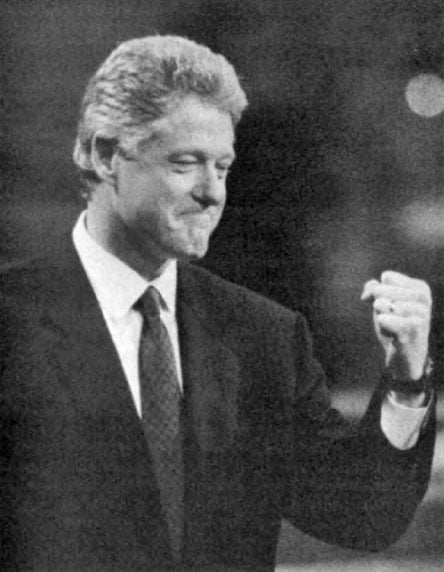

Down-mouth expression
What It Means: A more permanent version of the mouth shrug is a way people may show they’re unhappy, despondent, depressed, angry, or tense4https://www.amazon.com/Definitive-Book-Body-Language-attitudes/dp/1409168506.
Pro Tip: Our Face Carries History
Our face carries with us a history of our most-used expressions. Down-mouthing can even become a permanent feature throughout someone’s lifetime, sometimes known as the bulldog face, or it can lead to resting bitch face (RBF).
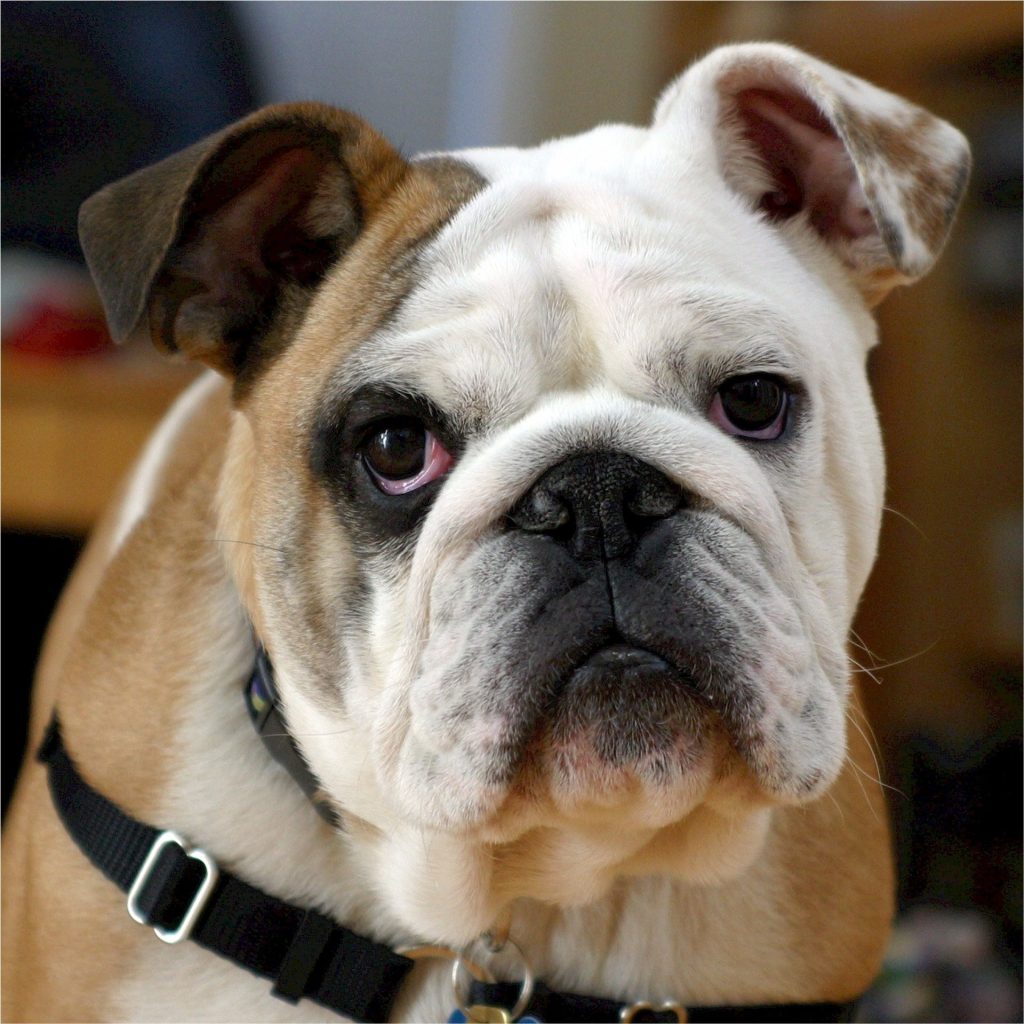
Studies show that we stand farther away from people with this expression, give less eye contact, and avoid them when they walk toward us5.
Lower lip biting
What It Means: Lower lip biting is used to display sexual attraction. Biting the lip can bring blood flow to our lips, making them appear redder.
Lip biting can also act as a pacifier if it’s done repeatedly. Biting the lips stimulates the same nerves in the mouth as sucking our thumbs6https://www.amazon.com/What-Every-Body-Saying-Speed-Reading/dp/0061438294.
Also, we might bite down hard when we want to say something but can’t or shouldn’t. You might notice lower lip biting if an employee gets reprimanded by his manager for something he didn’t do.
Upper lip biting
What It Means: Upper lip biting could indicate nervousness or anxiety. Watch for other gestures to confirm fear:
- raised eyebrows
- touching the suprasternal notch
- constricted pupils
Puckered lips or pushed-out lips
What It Means: Puckering or pouting can be a manipulative move, usually used by women when something doesn’t go their way. You may see this from a girlfriend when the boyfriend isn’t willing to comply. This is a way to signal others to help them during distress.
Pouts are also used by infants to promote bonding. However, pouting could also signal sadness or frustration. This gesture is more common among women, and some women may pout to show vulnerability, which activates men’s desire to protect them6https://www.amazon.com/What-Every-Body-Saying-Speed-Reading/dp/0061438294.
Bulging lips
What It Means: Bulging the lips is similar to puckering, but more deadly. Bulging is when a person pushes out air with their lips tightly closed. Coupled with a death glare, this cue is a common face in primates14https://www.emory.edu/LIVING_LINKS/publications/articles/Parr_etal_2005.pdf before attacking… or copulating.
Lip quivering
What It Means: Remember that phrase “Keep a stiff upper lip”? This means to stop lip quivering in the face of adversity or challenge.
But it may be impossible: lip quivering is our fear response. When we are in discomfort, concerned, fearful, or experience other issues, our lip may automatically quiver4https://www.amazon.com/Definitive-Book-Body-Language-attitudes/dp/1409168506. This happens because our face muscles tighten up in preparation for fight or flight.
We can also see this gesture in young people if they are being questioned by their parents.
Sucked-in lips
What It Means: If you take pursed lips to the extreme, you get sucked-in lips. Disappearing lips isn’t a good sign—it indicates high stress and anxiety. Most people can make their lips disappear, in fact, but only in a straight line. You may even notice the corners of the mouth turned into an upside-down U (which is extremely difficult for many people to do).
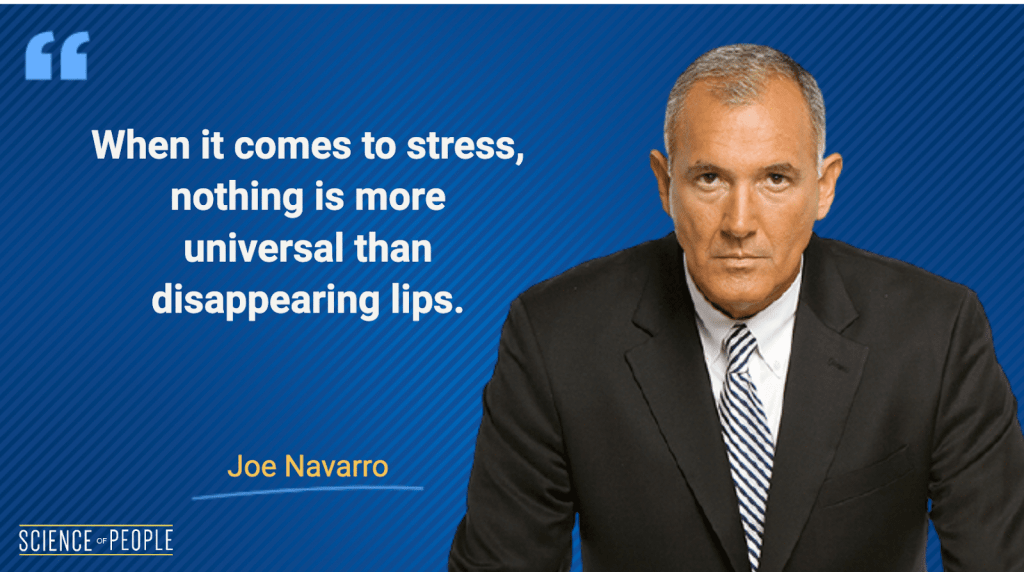
This limbic response is hard to mimic unless under great distress or grieving.
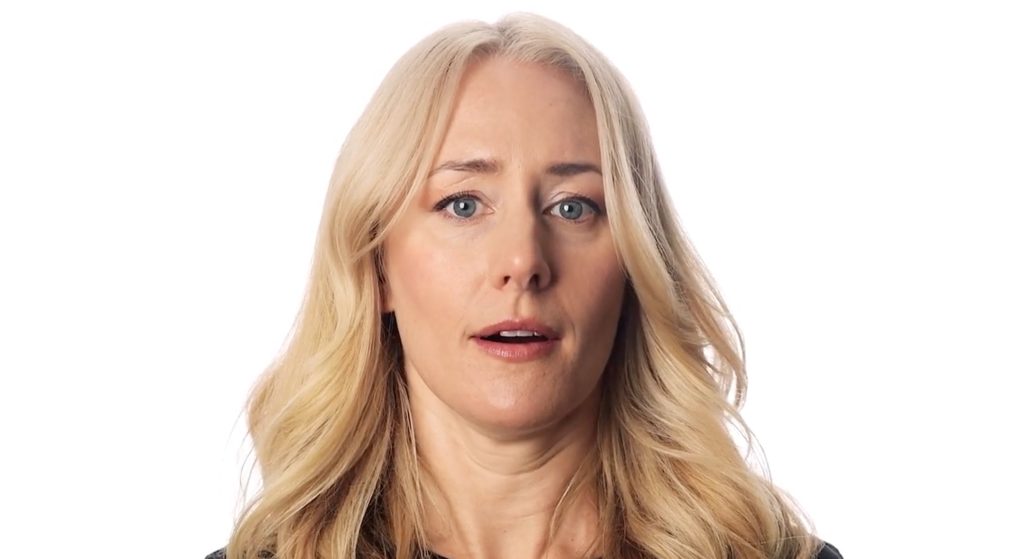
Parting lips
What It Means: Parted lips is a turn-taking behavior that signals someone wants to speak.
Pro Tip: Watch for Parted Lips in the Crowd
If you are scanning the room at a networking event or party, look for eye contact and then suddenly parted lips. This cluster may mean they want to talk to you. When lips are parted, you can usually see the teeth. You can take this as the first sign of conversation.
Women also part their lips to people they are attracted to. Combined with strong eye gaze and an exposed neck, this can be a strong flirtation signal.

7 Tongue Gestures You Should Know
The tongue is a small part of our mouth, yet it contains 8 muscles15https://smilesonmichigan.com/blog/7-facts-about-your-tongue/?__cf_chl_rt_tk=liaE9aPD1Ten_5JEmnx1gmQ3B8y34WbnoUwj.ywmUeI-1711386854-0.0.1.1-1258 to move. Many gestures are obvious, such as licking. But watch for tongue gestures that are hidden—sometimes you may even see a tongue poking out in a cheek! Let’s dive in.
Licking lips
What It Means: Licking the lips can be interpreted in many ways, but my favorite is when it indicates interest and attraction, baby! Licking the lips makes them shinier, and the tongue produces movements that attract our eyes.
There’s nothing more attractive than seeing licked lips, which is why you’ll see this in highly sexualized commercials and advertisements. And possibly when watching basketball.
Why do we see lip-licking in many attraction scenarios? It may mean the lip licker’s mouth is drying out. This happens more often on a date, which can be a side effect of increased breathing rate when the attraction ramps up (which is also why you might feel it’s harder to talk when on a date with a hot guy or attractive woman). Small movements of the tongue and lips help to replace lost moisture.
On the downside, licking the lips could also be interpreted as a sign of stress. Unprepared students may lick their lips when sitting down for a test6https://www.amazon.com/What-Every-Body-Saying-Speed-Reading/dp/0061438294.
Here’s an example of an interview of President Obrador from Mexico, where he is defending his brother, who was caught on tape receiving money in a suspicious way (timestamp 1:30):
Notice the lip licking and nose rubbing. These gestures may indicate stress but not necessarily lying.
Upper-lip tongue rubbing
What It Means: Upper-lip tongue rubbing may indicate positive emotions since the tongue goes upward and “defies” gravity. However, it could also indicate that someone is stressed.
Tongue sticking out
What It Means: Have you ever seen a kid stick their tongue out? Sienna does this all the time when we have playtime. Tongue jutting happens when we protrude our tongue between our teeth. It can typically mean we are being playful, or you may see it when people catch themselves making a small mistake6https://www.amazon.com/What-Every-Body-Saying-Speed-Reading/dp/0061438294.
Alternatively, it could also mean that somebody got away with a great bargain, a higher grade, a big lie, or… an extra cookie.
Sticking tongue out to side of mouth
What It Means: We can see babies push their mothers’ breasts away by sticking out their tongues—later, the same gesture evolves as a way to concentrate on difficult tasks or when being rude to someone16https://www.amazon.com/Peoplewatching-Desmond-Morris-Guide-Language/dp/0099429780.
Observers noticed that nursery school children protruded their tongue slightly when they wanted to avoid social contact. Or if someone was busy doing something, and it looked like others were about to interrupt them, they stuck their tongue out—only the tip of the tongue—as a way of saying, “Please leave me in peace”16https://www.amazon.com/Peoplewatching-Desmond-Morris-Guide-Language/dp/0099429780.
Tongue sloshing
What It Means: Tongue sloshing is a pacifying gesture, and we do it by moving our tongue back and forth from corner to corner of our open mouth. I often notice my husband sloshing his tongue whenever he’s stuck on a problem. Sloshing can also show we are thinking about what to say before saying it.
If you notice the tongue pressing against the palate, with the mouth slightly open, this also indicates struggle6https://www.amazon.com/What-Every-Body-Saying-Speed-Reading/dp/0061438294.
Licking teeth
What It Means: Licking your teeth is usually seen as a sign of aggression since teeth are a primitive weapon that we use when threatened. It can happen right before a fight or if someone enters your comfortable space without permission.
Clenched teeth can sometimes be seen even when the mouth is closed. For example, you might notice a tiny movement on the jaw area or side of the face that pushes the jaw up and slightly widens it6https://www.amazon.com/What-Every-Body-Saying-Speed-Reading/dp/0061438294. Additionally, teeth tapping shows signs of stress, boredom, or frustration. Some people might even shift their jaws and tap their canine teeth as a way to soothe themselves6https://www.amazon.com/What-Every-Body-Saying-Speed-Reading/dp/0061438294.
Tongue in cheek
What It Means: A person may demonstrate nervousness when they stick their tongue against the inside of their cheek. This helps to relieve tension and high stress. People may also do this if they want to hide or get away with something. Depending on the context, it can also be done if someone is being playful.
In response to Lance Armstrong’s contract with Livestrong being terminated, you can see him licking his lips, followed by a tongue in his cheek. This indicates high stress and anxiety. Right after that, you can see how he clearly opens up in a more confident posture when the interview shifts to how they did good with Livestrong and saved millions of lives (timestamp 16:26):

5 Mouth-Touching Gestures You Should Know
In one study17https://www.researchgate.net/publication/271647859_Face_touching_A_frequent_habit_that_has_implications_for_hand_hygiene of 26 medical students, researchers found that out of 2,346 times the students were observed touching their face, nearly 16% of the time involved the mouth. So while mouth touching isn’t super common, when it does happen, it usually means blocking behavior.
Here are 5 cues to watch out for:
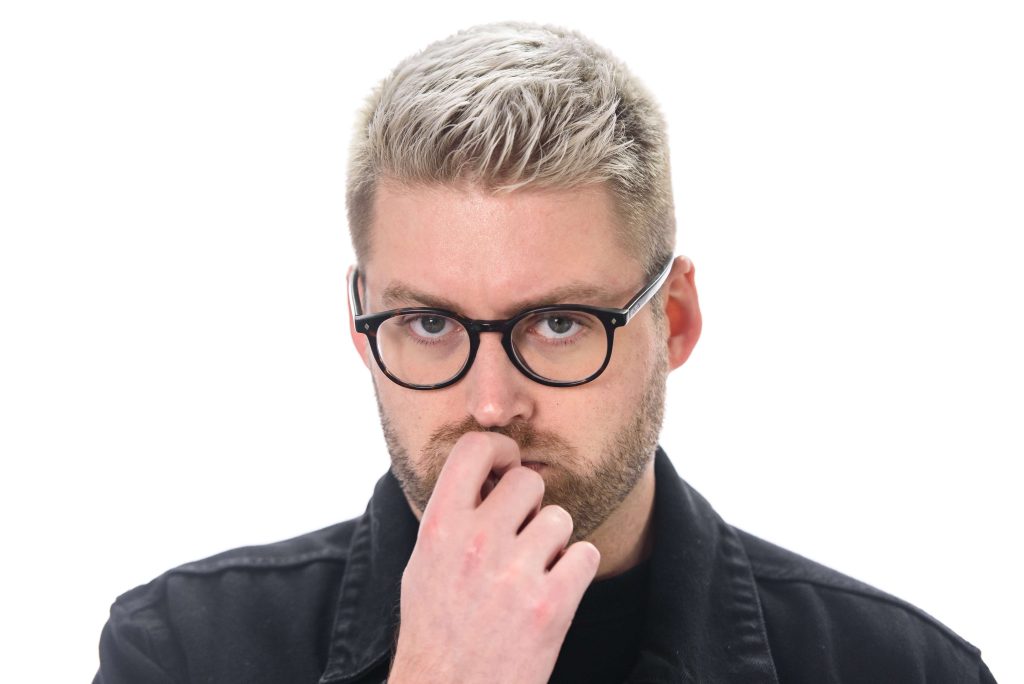
Fingertip on lip
What It Means: If you see someone put their fingertip on their lips, it can mean that they are sending you a signal of being seductive. Our finger draws attention to our lips, and you can see this in various fashion magazines:
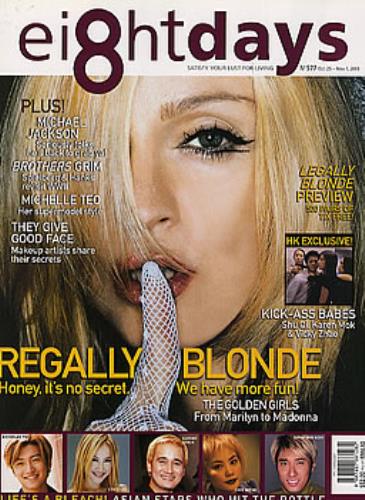
It may also be a self-soothing gesture, similar to how babies put objects in their mouths when they are exploring things in the world for the first time, or how a toddler sucks on their thumb. This could carry over to adulthood when someone is thinking or in response to a question.
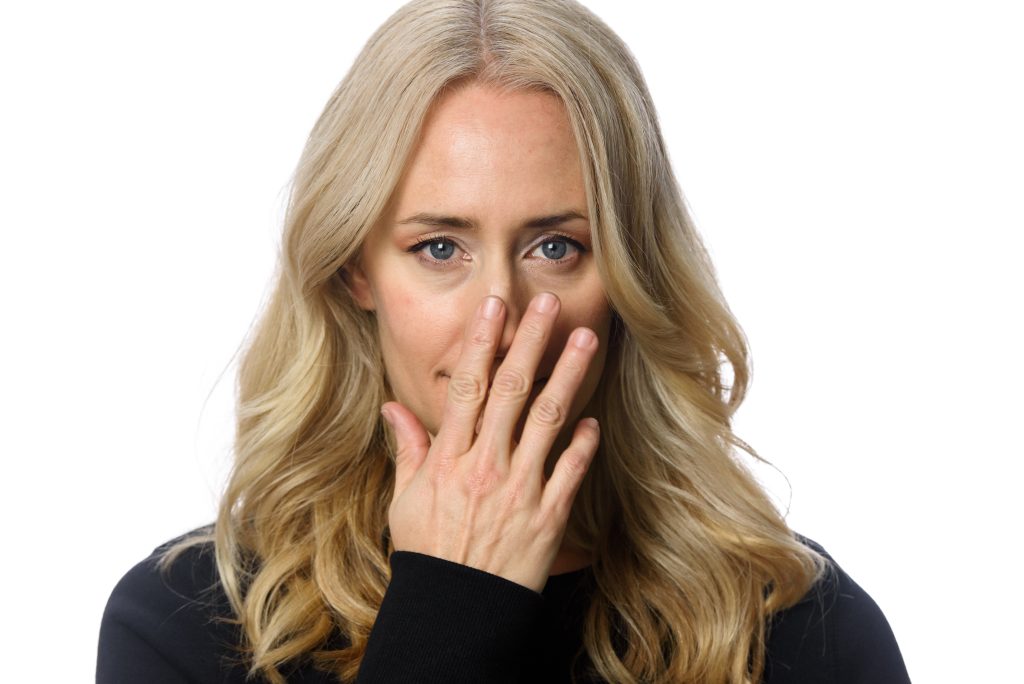
Covering mouth
What It Means: When someone covers their mouth, it can mean that they are trying to pacify themselves4https://www.amazon.com/Definitive-Book-Body-Language-attitudes/dp/1409168506. This may be because they feel high amounts of stress or are uncertain about a situation.
Creepy Video Warning!
Check out this video of a little girl in Russia. As she walks into a building, alone, a sketchy man observes her outside the building and decides to follow her in. As the man goes in, watch as he touches his mouth in a pacifying gesture (timestamp 0:52). Luckily, the girl catches on and escapes the building without a scratch!
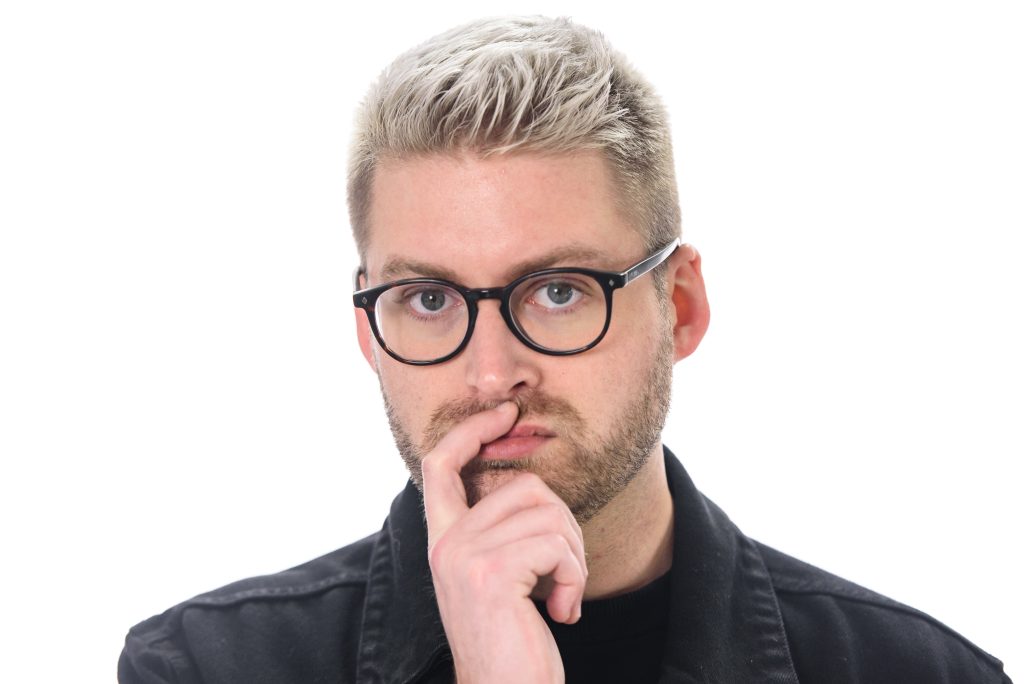
Touching the philtrum
What It Means: Fingers above the mouth in the philtrum area (that area of skin right above the lip) can mean low confidence, anxiety, or shyness. This is also a blocking behavior that covers the mouth, which may mean someone is hesitant to speak.
If they pluck this area, it may signal fear, doubt, concern, or lack of confidence12https://www.amazon.com/Dictionary-Body-Language-Field-Behavior/dp/0062846876.
Palm over mouth
What It Means: The palm-over-mouth gesture indicates surprise. You might see this if someone receives bad news over the phone. In some Eastern cultures, especially Japanese cultures, covering the mouth when talking is polite if they are laughing or eating, etc.
Pro Tip: How to Spot Negative Thinking Before a Word is Even Said
Sometimes, we may think before we speak. But those critical seconds before we speak often leak out critical info. For example, in a videotaped interview, the interviewee was asked a question and then suddenly covered his mouth and rubbed his nose for several seconds before answering4https://www.amazon.com/Definitive-Book-Body-Language-attitudes/dp/1409168506.
This was super different than his open body posture he was demonstrating before. So what gives?
When asked about it, he said he was thinking of 2 possible ways to respond. When he was thinking of the negative response and how the interviewer might react to it, that’s when he covered his mouth and rubbed his nose. But when he thought of the positive answer, his hand dropped from his mouth, and he immediately resumed his open body position. The bottom line is you can read emotions before anything is said… but be careful not to misinterpret.
Putting objects in mouth
What It Means: According to Morris18https://books.google.ro/books?id=7xzhVIwIqSMC&lpg=PA180&ots=BWWFrFNWBP&dq=desmond+morris+putting+objects+mouth&pg=PA180&redir_esc=y#v=onepage&q=desmond%20morris%20putting%20objects%20mouth&f=false, putting objects in or near the mouth mimics the same behavior of seeking comfort at our mother’s breast when we were infants. In some instances, the habit of nipple sucking transforms into nail biting and pencil sucking in some adolescents; then to gum chewing, sunglass sucking, biting on glasses, putting pencil or pen in our mouth, biting our nails, or cigarette, cigar, and pipe sucking during adulthood16https://www.amazon.com/Peoplewatching-Desmond-Morris-Guide-Language/dp/0099429780.
You may notice this behavior when our desire for security or reassurance spikes up, or if our needs are not being met, such as when we feel anxious, tense, or stressed.
People may also put things in their mouth to stall for time. You may notice this when asking a question and a person starts stalling—it’s a signal they are unsure, and reassurance is needed.
Otherwise, we may see objects put in the mouth to signal other sexual connotations during a date.
Pro Tip: How to Stop Someone From Object Sucking
Hey, I know it can be hard if someone is constantly nibbling on their pen. Sometimes it’s impossible, but if you notice someone putting a pen in their mouth, take a mental step back and go into reassurance mode: open your body up, be genuinely concerned, and get to the root of their anxiety. Offering reassurance is the best way to stop someone from putting objects in their mouth.

5 Gasping and Other Air Gestures to Know
How many times does air come in and out of your mouth? Most of us are nose breathers, but those times air does come out of our mouth can mean relief, fear, defeat, or accomplishment, among other things. Watch for duration and length to identify these cues:
Small gasp of air
What It Means: If someone suddenly opens their mouth just wide enough for some air to come in, they might be upset or feeling defeated and frustrated. You might also hear an audible gasp or notice air being sucked from the corner of their mouth, which can indicate pain.
You may also see a sharp breath in during normal conversation. This might mean a person desires to talk or have their turn in a conversation.
Large gasp of air
What It Means: We might take in a large gasp of air when something unbelievable has happened or to show we are extremely shocked.
Why does this happen? The fight-or-flight response requires us to inhale a large amount of oxygen to supply the body, in case of danger. Watch this funny clip as a man can’t believe he made a simple math mistake:
Sigh of air
What It Means: A small or short sigh of air usually means disappointment or even relief from something stressful. You might even hear someone say, “Woo, we’re finally done!” while letting out some air.
In the presidential debate between Al Gore and George W. Bush, Al Gore can be seen repeatedly sighing throughout the debate. This becomes negative. The exasperated sigh is only exaggerated with the microphone close to his mouth (timestamp 2:30):
Cathartic exhale
What It Means: A cathartic exhale is when a person puffs out their cheeks and holds their lips tight, indicating that stress is being experienced or has passed. You can see this after a test or interview is over or even after a near accident12https://www.amazon.com/Dictionary-Body-Language-Field-Behavior/dp/0062846876. This gesture is very audible and takes longer to perform… and if you’re close enough, you might even feel it (or smell it, bless you!).
You might even notice a cathartic exhale after someone holds their breath. Polygraphers know this gesture well—holding breath indicates a person may want to contain nervous breathing. This is part of our fight-or-flight response6https://www.amazon.com/What-Every-Body-Saying-Speed-Reading/dp/0061438294.
Whistling
What It Means: Whistling with the mouth can be pacifying6https://www.amazon.com/What-Every-Body-Saying-Speed-Reading/dp/0061438294. Some people whistle to calm themselves when walking through a strange area of a city or dark alleyway. Otherwise, it can be a sign that someone is really happy. There may be some science here, but the overall mood of whistling may also indicate a person’s mood.
And if you’re a woman, we may get the “flirting” catcall whistle used by men (in most cases, it’s totally unwanted!).

6 More Mouth Gestures to Know
In this final section, you’ll learn the rest of the mouth gestures that are still super, super important! Here they are, starting with:
Mouth stretching
What It Means: When we mouth stretch, we expose the bottom row of our clenched teeth while the corners of our mouth stretch downward and to the side. We do this when we feel afraid or realize that we’ve made a mistake. It’s often seen when someone forgets to bring something important, like when someone forgets to bring the power cable for their dead laptop for an important presentation (I’ve seen this once!).
Mouth wide open
What It Means: Our lips tend to form a huge oval shape, similar to the letter O, when we feel surprised or are in agony6https://www.amazon.com/What-Every-Body-Saying-Speed-Reading/dp/0061438294. This behavior is universal across cultures, possibly shared with primates when they are alarmed.
We’ve all seen it before, too. Remember The Scream? This is one you’ll likely remember forever:
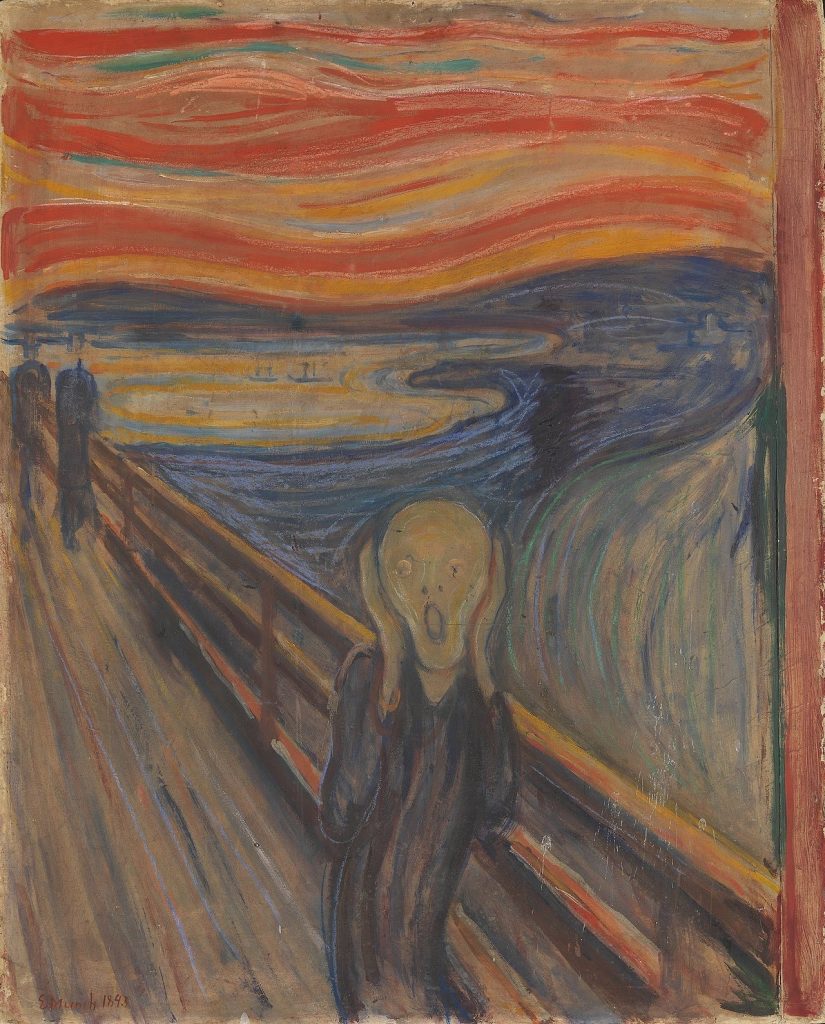

Yawning
What It Means: Yawning is a natural reflex of our body when tired (obvious, right?). However, did you know that too much yawning can mean you feel overly stressed, bored, or frustrated? Yawning relieves pent-up stress by stimulating the nerves in our jaws. But a rapid intake of air when yawning can indicate severe stress or hotness. This action cools blood circulation within the mouth’s palate. You might see yawning in office workers who constantly work overtime. This may mean they are both tired AND stressed.
Yawning also has another function. It creates rapport and avoids aggression, similar to how monkeys and chimps yawn to avoid fighting. Reports show soldiers fighting in recent wars experienced an overwhelming desire to sleep the moment they were ordered to attack—possibly due to a desire to avoid fighting6https://www.amazon.com/What-Every-Body-Saying-Speed-Reading/dp/0061438294.
Fun Fact: Yawning is Contagious
Have you ever seen someone yawn, and you yawn back? Studies19https://pubmed.ncbi.nlm.nih.gov/15820652/ show that we yawn out of empathy. Cats, dogs, and even turtles yawn, too, so it’s pretty common across species.
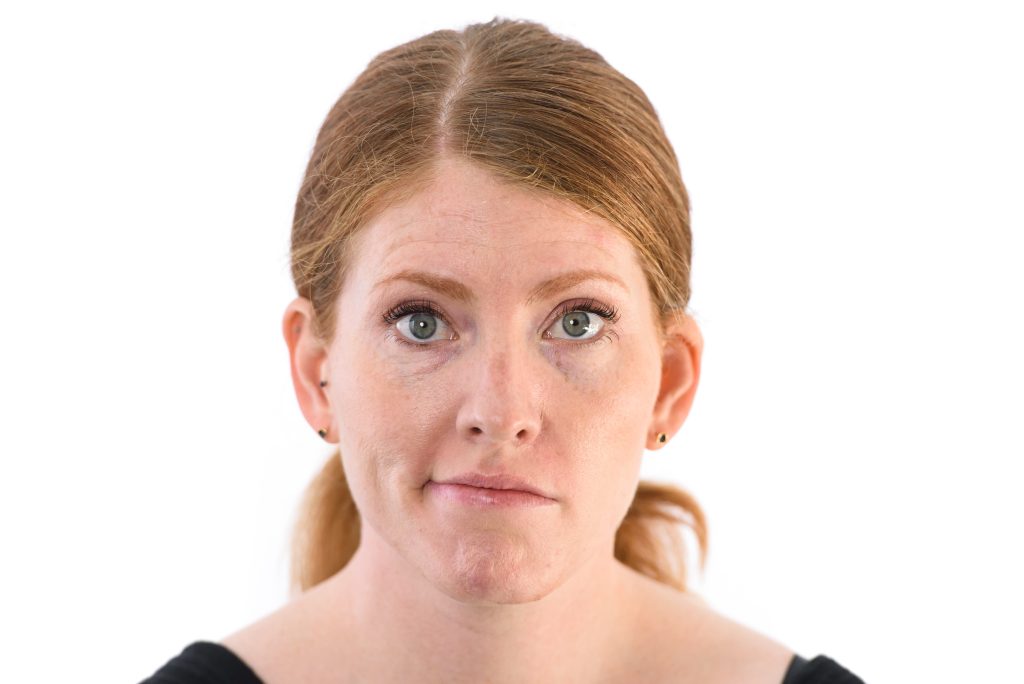
One side of mouth raised
What It Means: When someone raises one side of their mouth, it could indicate contempt.
Nicolas Fradet20https://nicolasfradet.com/microexpressions-tells-at-the-poker-table-contempt/ shows a great example of a poker player showing contempt (timestamp 0:17-0:18):
- Watch the first microexpression of disgust (see the rising of his upper lip and the opening of the nostrils)
- Right after that, the poker player shows contempt on the right side of his mouth (notice the crinkle below the right cheekbone). It is very, very improbable that a player can feel contempt (and disgust on top of that) while holding a great hand and feeling good about the situation.
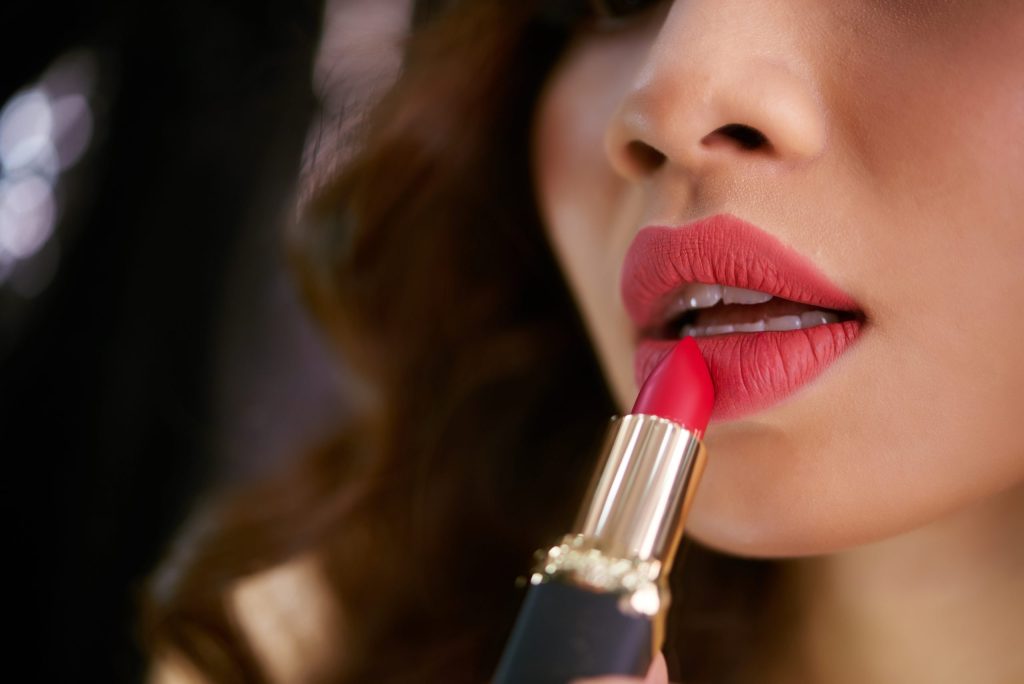
Lipstick
What It Means: Have you ever wondered why women wear lipstick? It’s not only a high-attraction cue in modern days—lipstick was actually invented all the way back 4,000 years ago in Egypt. It was intended to mimic the reddened genitals of the sexually aroused female.
And here’s something interesting: a woman’s outer genital lips are actually proportionately the same thickness as her facial lips4https://www.amazon.com/Definitive-Book-Body-Language-attitudes/dp/1409168506. Desmond Morris says this is “self-mimicry,” intended to symbolize the female genital region.
Pro Tip: The Color of Your Lipstick Matters!
According to one study, women wearing red lipstick to make their lips appear larger are seen as more interested in themselves and gaining men’s attention. Other experiments of women’s photos showed that men find bright red more attractive and sensual than other colors. However, women wearing muted or pastel colors tend to appear more career oriented and businesslike. And if a woman wears no lipstick? They are seen as more serious about work than even men. But on the downside, people see them as lacking personal skills4https://www.amazon.com/Definitive-Book-Body-Language-attitudes/dp/1409168506.
Smoking
What It Means: We all know smoking is an unhealthy, hazardous habit, but did you know that how someone smokes can be a tell? Let’s start with the ashtray:
- If you find someone tapping their ashtray repeatedly with their cigarette, this signifies a displacement gesture, which indicates tension or stress.
- If you even take a look inside their ashtray, you may notice piles of matches broken or snapped in half, patterns drawn in powdered ash, or hardly-touched cigarettes stamped out harshly. These are indicators of impatience or anger16https://www.amazon.com/Peoplewatching-Desmond-Morris-Guide-Language/dp/0099429780.
Pro Tip: Learn What People Think By Observing Their Smoke Direction
What about how someone smokes? Generally, up = positive and down = negative. In sWhat about how someone smokes? Generally, up = positive and down = negative. In selling situations, when smokers are asked to buy, those who’d already reached a positive decision were observed to blow smoke upward, and those who’d decided not to buy blew downward. And during a celebration dinner where cigars were distributed freely, out of 400 recorded cigar-smoke exhalations, 320 were in an upward direction4https://www.amazon.com/Definitive-Book-Body-Language-attitudes/dp/1409168506.
You may also notice how smokers will often whip out a cigarette during the most tense moments of a negotiation, such as when bargaining for a final price4https://www.amazon.com/Definitive-Book-Body-Language-attitudes/dp/1409168506.
Smokers stall using cigarettes. To make a quicker decision, consider negotiating in a building without smoke rooms.
The Peases noted that at a celebration dinner where cigars were distributed freely, of 400 recorded cigar-smoke exhalations, 320 were in an upward direction.
Besides these body language cues, there are a plethora of cues you can learn from—cues from the toes all the way to the head. Want to learn from a science-backed guide? We’ve got you covered:
Crack The Code on Facial Expressions
The human face is constantly sending signals, and we use it to understand the person’s intentions when we speak to them.
In Decode, we dive deep into these microexpressions to teach you how to instantly pick up on them and understand the meaning behind what is said to you.
Don’t spend another day living in the dark.
Side Note: As much as possible we tried to use academic research or expert opinion for this master body language guide. Occasionally, when we could not find research we include anecdotes that are helpful. As more research comes out on nonverbal behavior we will be sure to add it!
This article is part of our body language guide. Click here for more.
Article sources
- https://www.sportscasting.com/michael-jordans-father-was-the-reason-his-tongue-was-always-sticking-out/
- https://www.amazon.com/Nonverbal-Communication-Human-Interaction-Knapp/dp/1133311598
- https://www.ncbi.nlm.nih.gov/pmc/articles/PMC5902524/
- https://www.amazon.com/Definitive-Book-Body-Language-attitudes/dp/1409168506
- https://www.researchgate.net/publication/11931976_Are_Emotions_Contagious_Evoked_Emotions_while_Viewing_Emotionally_Expressive_Faces_Quality_Quantity_Time_Course_and_Gender_Differences
- https://www.amazon.com/What-Every-Body-Saying-Speed-Reading/dp/0061438294
- https://www.psychologytoday.com/intl/blog/cutting-edge-leadership/201604/5-types-smiles-and-what-they-mean
- https://www.researchgate.net/publication/243768681_Human_facial_expressions_as_adaptations_Evolutionary_questions_in_facial_expression_research
- https://www.amazon.com/You-Say-More-Than-Think/dp/0307453987
- http://www.communicationcache.com/uploads/1/0/8/8/10887248/are_smiles_a_sign_of_happiness_-_gold_metal_winners_at_the_olymic_games.pdf
- https://www.amazon.com/Winning-Body-Language-Conversation-Attention/dp/0071700579
- https://www.amazon.com/Dictionary-Body-Language-Field-Behavior/dp/0062846876
- https://benjamins.com/catalog/gest.16.1.01deb/fulltext/gest.16.1.01deb.pdf
- https://www.emory.edu/LIVING_LINKS/publications/articles/Parr_etal_2005.pdf
- https://smilesonmichigan.com/blog/7-facts-about-your-tongue/?__cf_chl_rt_tk=liaE9aPD1Ten_5JEmnx1gmQ3B8y34WbnoUwj.ywmUeI-1711386854-0.0.1.1-1258
- https://www.amazon.com/Peoplewatching-Desmond-Morris-Guide-Language/dp/0099429780
- https://www.researchgate.net/publication/271647859_Face_touching_A_frequent_habit_that_has_implications_for_hand_hygiene
- https://books.google.ro/books?id=7xzhVIwIqSMC&lpg=PA180&ots=BWWFrFNWBP&dq=desmond+morris+putting+objects+mouth&pg=PA180&redir_esc=y#v=onepage&q=desmond%20morris%20putting%20objects%20mouth&f=false
- https://pubmed.ncbi.nlm.nih.gov/15820652/
- https://nicolasfradet.com/microexpressions-tells-at-the-poker-table-contempt/
3 thoughts on “39 Mouth Body Language Gestures to Spot in Your Next Convo”
Comments are closed.
How to Deal with Difficult People at Work
Do you have a difficult boss? Colleague? Client? Learn how to transform your difficult relationship.
I’ll show you my science-based approach to building a strong, productive relationship with even the most difficult people.

There is one I think you may have missed. I, at least, didn’t see it listed. It is when the person makes an up-side-down smile, but nods their head in approval. The one that came close was the one where the person had an up-side-down smile, but they had no opinion or didn’t care.
There is one I think you may have missed. I, at least, didn’t see it listed. It is when the person makes an up-side-down smile, but nods their head in approval. The one that came close was the one where the person had an up-side-down smile, but they had no opinion or didn’t care.
There is one I think you may have missed. I, at least, didn’t see it listed. It is when the person makes an up-side-down smile, but nods their head in approval. The one that came close was the one where the person had an up-side-down smile, but they had no opinion or didn’t care.